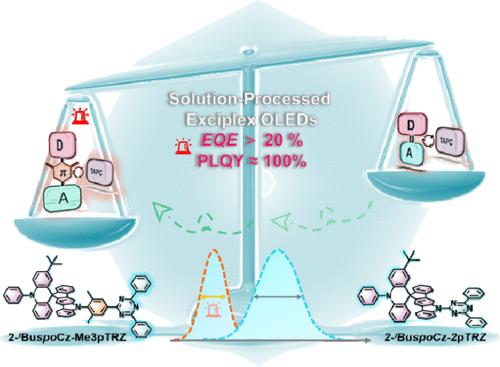New Concept for HLCT Emitter: Acceptor Molecule in Exciplex System for Highly Efficient and Extremely Low-Efficiency Roll-Off Solution-Processed OLED
IF 11.3
1区 化学
Q1 CHEMISTRY, PHYSICAL
引用次数: 0
Abstract
The use of hybridized local and charge-transfer (HLCT) emitters as acceptor or donor molecules in exciplex systems is still a novel concept even though HLCT molecules can harvest both singlet and triplet excitons. Herein, two HLCT emitters, 2-tBuspoCz-2pTrz and 2-tBuspoCz-Me3pTrz, are prepared as acceptors of exciplexes with thermally activated delayed fluorescence (TADF) properties. The exciplex TADF systems constructed by mixing HLCT and TAPC molecules have a minute energy gap between singlet and triplet excited states and unity emission efficiency. Using the exciplex as an emitter, solution-processed devices achieve maximum external quantum efficiency (EQEmax) of 16.6%. Impressively, solution-processed devices with the fabricated exciplexes as hosts exhibit extremely low turn-on voltages and a promising EQEmax of >20%, which is concomitant with an extremely low-efficiency roll-off of 0.5% at 1,000 cd m–2. This study explores the potential of HLCT emitters as acceptors of exciplexes and guides the design of efficient exciplex systems.

HLCT 发射器的新概念:用于高效和极低效率滚降溶液加工型有机发光二极管的复合系统中的受体分子
尽管杂化局域和电荷转移(HLCT)发射体分子可以收集单线和三线激子,但在激元系统中使用杂化局域和电荷转移(HLCT)发射体作为受体或供体分子仍然是一个新概念。本文制备了两种 HLCT 发射器,即 2-tBuspoCz-2pTrz 和 2-tBuspoCz-Me3pTrz,作为具有热激活延迟荧光(TADF)特性的赋形剂的受体。由 HLCT 和 TAPC 分子混合构建的赋形剂 TADF 系统在单线激发态和三线激发态之间具有微小的能隙,且发射效率相同。使用该复合物作为发射体,溶液处理装置的最大外部量子效率(EQEmax)达到 16.6%。令人印象深刻的是,以制备的赋形剂为宿主的溶液加工器件显示出极低的开启电压和有望达到 20% 的 EQEmax,同时在 1,000 cd m-2 时具有 0.5% 的极低效率衰减。这项研究探索了 HLCT 发射器作为赋形剂受体的潜力,并为高效赋形剂系统的设计提供了指导。
本文章由计算机程序翻译,如有差异,请以英文原文为准。
求助全文
约1分钟内获得全文
求助全文
来源期刊

ACS Catalysis
CHEMISTRY, PHYSICAL-
CiteScore
20.80
自引率
6.20%
发文量
1253
审稿时长
1.5 months
期刊介绍:
ACS Catalysis is an esteemed journal that publishes original research in the fields of heterogeneous catalysis, molecular catalysis, and biocatalysis. It offers broad coverage across diverse areas such as life sciences, organometallics and synthesis, photochemistry and electrochemistry, drug discovery and synthesis, materials science, environmental protection, polymer discovery and synthesis, and energy and fuels.
The scope of the journal is to showcase innovative work in various aspects of catalysis. This includes new reactions and novel synthetic approaches utilizing known catalysts, the discovery or modification of new catalysts, elucidation of catalytic mechanisms through cutting-edge investigations, practical enhancements of existing processes, as well as conceptual advances in the field. Contributions to ACS Catalysis can encompass both experimental and theoretical research focused on catalytic molecules, macromolecules, and materials that exhibit catalytic turnover.
 求助内容:
求助内容: 应助结果提醒方式:
应助结果提醒方式:


